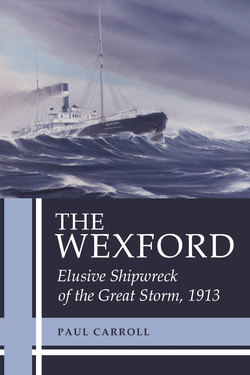Читать книгу The Wexford - Paul Carroll - Страница 9
На сайте Литреса книга снята с продажи.
ОглавлениеCOLOUR PLATES
Following page 144
Plate 1. The Last Sighting, oil, 2000, artist Captain C. “Bud” Robinson, showing the Wexford as she struggled with the heavy seas offshore from Goderich on the afternoon of Sunday November 9, 1913, just as the storm began to intensify to horrific proportions. The image of the Goderich Lighthouse, for which improvement plans had been designed but never enacted, is shown in the background on the right hand side. This striking painting is now owned by Mr. and Mrs. Keith Homan, The Ridge, Ridgewood Park, Goderich. In describing his painting, Bud cites the lines of the poem The Dirge of the Lakelands by Captain William Leonard:
Where is the lea or shelter
For we — of the nation’s care.
Courtesy of Captain C. “Bud” Robinson.
Plate 2. The Wexford, watercolour, 2001, artist Robert McGreevy, perhaps as she steamed along in a lull between the beginning and the end of the storm, downbound on Lake Huron, early in the day, in a strong northwesterly breeze. The artist has completed hundreds of magnificent paintings to preserve and to celebrate our extensive marine heritage on both sides of the international border that runs through our Great Lakes. Mr. McGreevy went out of his way to make an accurate scan of this image available for use in this book. He drove for several hours to pick up the original painting from its current owner, remove it from its frame, transport it to a professional printer, reassemble it, and, then return it to the owner. Courtesy of Robert McGreevy.
Plate 3. The Wexford, acrylic, 2000, artist William Nieuwland, from an aerial perspective as she is whipped by the winds and lashed by heavy seas during her last voyage. The artist created his image at the time of the discovery of the Wexford. There was a sizeable group established, The Friends of the Wexford, which took pains to try to protect the vulnerable wreck site as well as to celebrate the significance of her discovery in the waters northwest of Grand Bend. Courtesy of William Nieuwland.
Plate 4. The Goderich Lighthouse, circa 1900, watercolour, 2000, by the author, showing the storm signals in place, as another late November gale intensified. The original photograph is from the collection of Duncan and Linda Jewell and is used in the text. Although most sources suggest that the lighthouse was improved on the basis of needs made apparent by the tragic events of the Great Storm of 1913, recent archival drawings show that certain upgrades were already on the drawing boards before this horrific maritime event.
Plate 5. Vessels in Winter Storage at Goderich Harbour, circa 1910, colourized postcard from a photograph by Reuben R. Sallows of one of the few occasions the Wexford wintered at Goderich. The vessels shown are as follows: The tug in the foreground might be the W.L. Forrest. Beginning on the left side closest to the elevator: the Paliki, the J.A.McKee, and our Wexford. The three in the background are the Dundee, the Midland Queen, and the Neeping. To the right of the tall chimney on the water and electric plant is the Turret Chief or possibly the Turret Cape. These ship names have been verified after additional research by Captain “Bud” Robinson. Colourized postcard published by James F. Thompson, Goderich, colourized by The Valentine & Sons’ Publishing Co. Ltd., Montreal and Toronto. Printed in Great Britain. Courtesy of Glen I. Gardiner.
Plate 6. The Wexford in Harbour at Collingwood, colourized postcard from the collection at the Collingwood Museum. The image shows the Wexford beside a smaller unidentified vessel in the Collingwood shipyards of the Collingwood Shipbuilding & Engine Company Limited as she underwent repairs. Original postcard by the Valentine & Sons’ Publishing Co. Ltd., Montreal and Toronto. Printed in Great Britain. Courtesy of the Collingwood Museum, Access Number X969-549-1Harbour.
Plate 7 The Turret Chief. Iced up at Goderich Elevators, circa 1907, another “floating hearse” lost on Lake Superior in the 1913 Great Storm, but recovered the following year. Ice from late season storms had a major effect on the viability of ships to weather intense conditions. In addition to violent winds and tumultuous waves, ice encrustation must have played a major role in the foundering of some vessels lost in the Great Storm. This image is sometimes misidentified as the Wexford. Courtesy of Bob Carey and Glen I. Gardiner.
Plate 8(a) The R.M. Hudson Flag. This is the flag first carried by the Wexford at the time of her construction in 1883. Over her lifetime she carried the shipping flags of three different companies. Image as shown in the 1904 edition of Lloyd’s Book of House Flags and Funnels of the Principal Steamship Lines of the World and the House Flags of Various Lines of Sailing Vessels, Lloyd’s Registry, London. Image created by Captain “Bud” Robinson.
Plate 8(b) The Signal Flags of 1899. The signal flags are shown in a poster as produced for mariners by the Maryland Weather Service in 1899. The signal system was not the same as that used on the Canadian side of the Great Lakes. In a lighter moment, during one inquest following the Great Storm, it was reported that ships’ masters hung their coats over their barometers so as not to be distracted by the “falling glass.” Courtesy of National Oceanographic and Atmospheric Administration Historical Collection, Image 01823; Maryland Weather Service.
